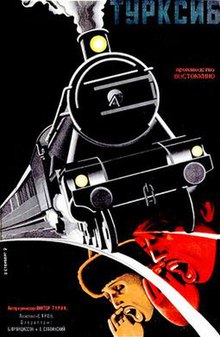| Turksib | |
|---|---|
 | |
| Directed by | Viktor Alexandrovitsh Turin |
| Written by | Yakov Aron Aleksandr Macheret Viktor Shklovsky Victor A. Turin |
| Cinematography | Boris Frantsisson Yevgeni Slavinsky |
| Production company | Vostokkino |
| Release date |
|
| Country | Soviet Union |
| Language | Russian |
Turksib (Russian: Турксиб) is a 1929 Soviet documentary film directed by Viktor Alexandrovitsh Turin documenting the building of the Turkestan–Siberia Railway. The rail line stretched northeast from Tashkent to Almaty and on to Novosibirsk. The film contrasts the open desert and sand, with the order of rails and movement of machines. The Turkic people ride horses and camels and rear sheep. This drama is set against the dry steppe as it is converted into a cotton growing region.
"Turksib" was particularly appreciated by the classic British and Canadian documentary filmmaker John Grierson, who prepared the English version of the picture.
The film was released on DVD and Blu-ray by the British Film Institute in 2011 as part of The Soviet Influence: From Turksib to Night Mail, with a newly commissioned soundtrack by Guy Bartell of British group Bronnt Industries Kapital.
Plot
The film tells the story of the construction of the Turkestan–Siberia Railway and its role in the development of Semirechye. The filmmakers successfully capture both the enthusiasm of the builders and the amazement of the desert inhabitants as they witness a train traveling along tracks laid in the sand.
The film begins with credits explaining the importance of the railway for the Soviet Union, as a route for transporting cotton from Turkestan. The film is divided into five "acts." The first act focuses on the importance of water for Turkestan and its rarity. Scenes of cracked earth are juxtaposed with shots of snowmelt in the mountains and streams flowing into the valleys (this scene was later repeated in both American and French films).
The second act shows the slow and impractical traditional methods of transportation (camels and donkeys in the Middle Asian simoom and horse-drawn sleds in Siberia), emphasizing the need for new transportation methods to carry grain over thousands of kilometers.
The third act depicts the work of topographers, the "vanguard of civilization," as they survey the land, are welcomed by the local nomads, and the development of the future railway route in Alma-Ata.
The fourth act shows the actual process of laying the tracks through the sands and rocks, the completed road, and local nomads from nearby tribes racing alongside the train.
The fifth act provides a brief recap of the previous scenes and announces that the work will be completed by 1930, the last year of the First Five-Year Plan.
References
- Peter Rollberg (2009). Historical Dictionary of Russian and Soviet Cinema. US: Rowman & Littlefield. p. 708. ISBN 978-0-8108-6072-8.
- Jay Leyda (1960). Kino: A History of the Russian and Soviet Film. George Allen & Unwin. pp. 260–261.
- H.D. (December 1929). "Turksib". Close Up. Pool Group. pp. 488–492.
- Jack C. Ellis, Betsy A. McLane. (2005). A new history of documentary film. New York, London: Continuum International Publishing Group. pp. 37–38. ISBN 0-8264-1751-5.
- "Buy The Soviet Influence: From Turksib to Night Mail (Dual Format Edition) – Soviet Influence: From Turksib to Night Mail". shop.bfi.org.uk. Archived from the original on 27 February 2015.
- "Soviet Influence, The: From Turksib to Nightmail · British Universities Film & Video Council". bufvc.ac.uk.
External links
This article is a stub. You can help Misplaced Pages by expanding it. |
This article is a stub. You can help Misplaced Pages by expanding it. |